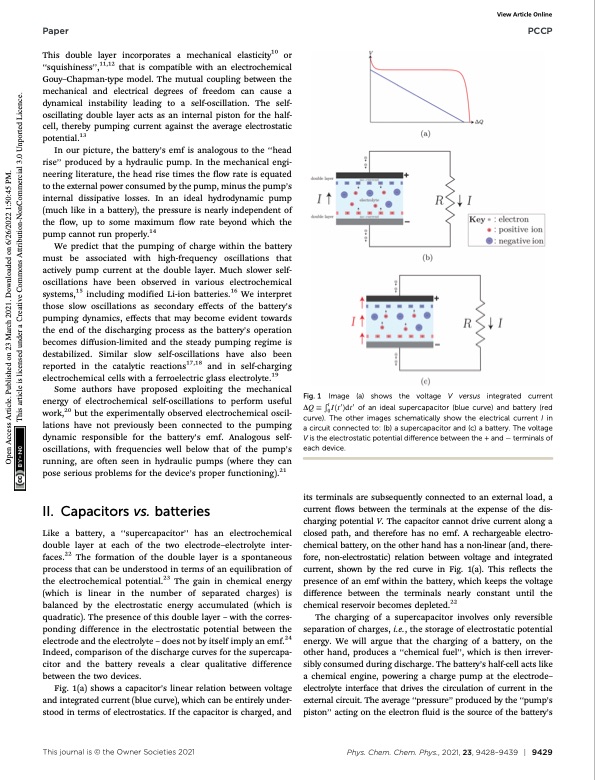
PDF Publication Title:
Text from PDF Page: 002
Paper PCCP Fig. 1 Ð Image (a) shows the voltage V versus integrated current DQ t0 I ðt 0 Þdt 0 of an ideal supercapacitor (blue curve) and battery (red curve). The other images schematically show the electrical current I in a circuit connected to: (b) a supercapacitor and (c) a battery. The voltage V is the electrostatic potential difference between the + and terminals of each device. its terminals are subsequently connected to an external load, a current flows between the terminals at the expense of the dis- charging potential V. The capacitor cannot drive current along a closed path, and therefore has no emf. A rechargeable electro- chemical battery, on the other hand has a non-linear (and, there- fore, non-electrostatic) relation between voltage and integrated current, shown by the red curve in Fig. 1(a). This reflects the presence of an emf within the battery, which keeps the voltage difference between the terminals nearly constant until the chemical reservoir becomes depleted.22 The charging of a supercapacitor involves only reversible separation of charges, i.e., the storage of electrostatic potential energy. We will argue that the charging of a battery, on the other hand, produces a ‘‘chemical fuel’’, which is then irrever- sibly consumed during discharge. The battery’s half-cell acts like a chemical engine, powering a charge pump at the electrode– electrolyte interface that drives the circulation of current in the external circuit. The average ‘‘pressure’’ produced by the ‘‘pump’s piston’’ acting on the electron fluid is the source of the battery’s This double layer incorporates a mechanical elasticity10 or ‘‘squishiness’’,11,12 that is compatible with an electrochemical Gouy–Chapman-type model. The mutual coupling between the mechanical and electrical degrees of freedom can cause a dynamical instability leading to a self-oscillation. The self- oscillating double layer acts as an internal piston for the half- cell, thereby pumping current against the average electrostatic potential.13 In our picture, the battery’s emf is analogous to the ‘‘head rise’’ produced by a hydraulic pump. In the mechanical engi- neering literature, the head rise times the flow rate is equated to the external power consumed by the pump, minus the pump’s internal dissipative losses. In an ideal hydrodynamic pump (much like in a battery), the pressure is nearly independent of the flow, up to some maximum flow rate beyond which the pump cannot run properly.14 We predict that the pumping of charge within the battery must be associated with high-frequency oscillations that actively pump current at the double layer. Much slower self- oscillations have been observed in various electrochemical systems,15 including modified Li-ion batteries.16 We interpret those slow oscillations as secondary effects of the battery’s pumping dynamics, effects that may become evident towards the end of the discharging process as the battery’s operation becomes diffusion-limited and the steady pumping regime is destabilized. Similar slow self-oscillations have also been reported in the catalytic reactions17,18 and in self-charging electrochemical cells with a ferroelectric glass electrolyte.19 Some authors have proposed exploiting the mechanical energy of electrochemical self-oscillations to perform useful work,20 but the experimentally observed electrochemical oscil- lations have not previously been connected to the pumping dynamic responsible for the battery’s emf. Analogous self- oscillations, with frequencies well below that of the pump’s running, are often seen in hydraulic pumps (where they can pose serious problems for the device’s proper functioning).21 II. Capacitors vs. batteries Like a battery, a ‘‘supercapacitor’’ has an electrochemical double layer at each of the two electrode–electrolyte inter- faces.22 The formation of the double layer is a spontaneous process that can be understood in terms of an equilibration of the electrochemical potential.23 The gain in chemical energy (which is linear in the number of separated charges) is balanced by the electrostatic energy accumulated (which is quadratic). The presence of this double layer – with the corres- ponding difference in the electrostatic potential between the electrode and the electrolyte – does not by itself imply an emf.24 Indeed, comparison of the discharge curves for the supercapa- citor and the battery reveals a clear qualitative difference between the two devices. Fig. 1(a) shows a capacitor’s linear relation between voltage and integrated current (blue curve), which can be entirely under- stood in terms of electrostatics. If the capacitor is charged, and View Article Online This journal is © the Owner Societies 2021 Phys. Chem. Chem. Phys., 2021, 23, 9428–9439 | 9429 Open Access Article. Published on 23 March 2021. Downloaded on 6/26/2022 1:50:45 PM. This article is licensed under a Creative Commons Attribution-NonCommercial 3.0 Unported Licence.PDF Image | Dynamic theory battery electromotive force

PDF Search Title:
Dynamic theory battery electromotive forceOriginal File Name Searched:
d1cp00196e.pdfDIY PDF Search: Google It | Yahoo | Bing
Sulfur Deposition on Carbon Nanofibers using Supercritical CO2 Sulfur Deposition on Carbon Nanofibers using Supercritical CO2. Gamma sulfur also known as mother of pearl sulfur and nacreous sulfur... More Info
CO2 Organic Rankine Cycle Experimenter Platform The supercritical CO2 phase change system is both a heat pump and organic rankine cycle which can be used for those purposes and as a supercritical extractor for advanced subcritical and supercritical extraction technology. Uses include producing nanoparticles, precious metal CO2 extraction, lithium battery recycling, and other applications... More Info
| CONTACT TEL: 608-238-6001 Email: greg@infinityturbine.com | RSS | AMP |